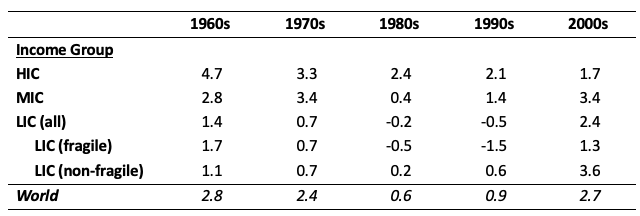Tuesday, April 16, 2019
It’s too soon for optimism about convergence
From VoxEU post by Paul Johnson and Chris Papageorgiou:
“The recent wave of growth in several developing economies has led to many analysts to claim that poorer countries are catching up with advanced economies. This column argues that, with the exception of a few countries in Asia which exhibited transformational growth, most of the economic achievements in developing economies have been the result of removing inefficiencies which are merely one-off level effects. While these effects are not unimportant and are necessary in the process of development, they do not imply ongoing economic growth.
In the past 50 years or so, the gap between average living standards in the poorest countries of the world and those in the richest countries has grown markedly. This unwelcome change is contrary to the proposition that less advanced economies ought to be able to catch up to more advanced economies through capital accumulation and technology transfer. Although the proposition wasn’t new, Abramowitz’s (1986) and Baumol’s (1986) examinations of its veracity as a negative correlation between initial per capita income levels and subsequent growth in per capita income, initiated a vast literature testing the so-called convergence hypothesis.1 Following Barro and Sala-i-Martin (1990), the catch-up approach to the convergence hypothesis became known as β-convergence.2
Table 1 provides some insight into what has driven the widening gap between the poorest countries and the richest countries. It shows decadal average per capita GDP growth rates for low, upper-middle, and high-income countries (LICs, MICs, and HICs respectively) over the 50-year period from 1960 to 2010.
Table 1 Decadal average per capita GDP growth (%) by income
Notes: This table is an abridged version of Table 2 in Johnson and Papageorgiou (2018) where data sources and other details are given. There are 29 HICs, 68 MICs, and 51 LICs. Appendix Table A.1 in Johnson and Papageorgiou (2018) lists the countries in each group.
Despite the slowdown in their average growth rates over this period, the HICs have typically grown more quickly than the MICs, which in turn have grown more quickly than the LICs. These differences are the exact opposite of the pattern required for catching up to be observed, and so it is hardly a surprise that the dispersion of per capita GDP across countries has grown markedly since 1960. This growth is documented in Figure 1, which plots the standard deviation of the cross-country distribution of GDP per capita for a constant group of countries from 1960 to 2010 and shows that, apart from a small decline in the very late 2000s, the dispersion has risen steadily since 1960.
In addition to lagging that of the HICs and MICs, the growth experience of the poorest countries from 1960 to 2010 has been heterogeneous, both across countries and over time. Table 1 shows that the LICs experienced a continuous decline in growth rates in every decade from the 1960s to the 1990s, with negative growth rates in the 1980s and 1990s, before the surprising and unprecedented resurgence of growth in the 2000s. The MICs saw a similar resurgence in the 2000s although their slowing in the 1980s did not produce the negative growth rates experienced in the LICs.
Table 1 also makes the distinction between what are commonly called fragile and non-fragile LICs. Fragile states are those facing political frailty, characterised by weak institutional capacity, poor governance, corruption, and conflict. This distinction illuminates the marked differences in the growth experiences of the fragile LICs and the non-fragile of LICs, most notably in the 1990s and 2000s when the annual average growth rates differ by over 2 percentage points. That is, while there is a lot of optimism over the most recent growth acceleration in LICs, aggregating their experience masks the fact that only about half of the LICs are contributing to the resurgence while the rest are stagnant.”
Continue reading here.
Posted by at 9:44 AM
Labels: Inclusive Growth
Subscribe to: Posts
